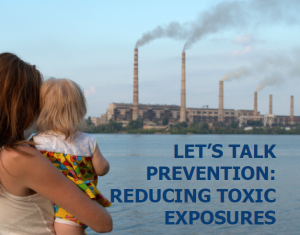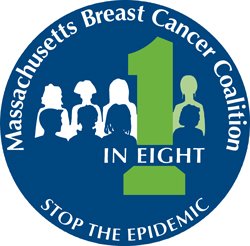Let’s Talk Prevention: Reducing Toxic Exposures is an educational program to increase discussions about environmental exposures between health professionals and patients through the distribution and use of a booklet for health professionals and brochure for patients. The goal of this program to reduce toxic exposures holds implications for reducing the burden of all environmentally-linked diseases, including breast cancer.

Living a healthy lifestyle through proper diet, exercise, and limiting alcohol and tobacco use is important but won’t reduce the burden of environmentally-linked diseases. Additional changes must be made to reduce exposure to chemicals linked with health consequences including cancer, birth defects, reproductive problems, and more. Minimizing exposure to chemicals linked with negative health impacts can lessen the burden of disease and improve public health.
Why Reduce Exposure?
Scientists are increasingly demonstrating links between environmental exposures and human health impacts. Known or suspected carcinogens and endocrine-disrupting chemicals have been detected in our air, water, soil, food, and consumer products. The CDC’s biomonitoring studies show hundreds of synthetic chemicals in the blood and urine of average American citizens,[i] while federal agency reports calculate that complete health screening data is available for only approximately 7% of over 84,000 chemicals currently registered for use.[ii]
The Program:
Let’s Talk Prevention Community Handouts: Learn basic steps to reduce toxic exposures, find tips to choose safer alternatives to toxic products, and view or download the handout, available in 11 languages.
Let’s Talk Prevention: Actions You Can Take Student Modules: Our Let’s Talk Prevention: Actions You Can Take Student Modules are part of a free environmental education program that educators and students can use to encourage conversations around environmental exposures to toxins. The Student Modules use evidence-based research to create age-appropriate, fun, and educational activities for elementary, middle, high school, and homeschool students. We developed these Student Modules in partnership with Silent Spring Institute, supported with funding by the National Institute of Environmental Health Sciences (NIEHS).
Let’s Talk Prevention for Health Professionals: Read advice on discussing environmental exposures with patients and review a list of potential questions to ask in determining environmental exposure histories. Download the complete booklet for health professionals, which summarizes exposure sources, classifications, scientific evidence linking exposure and effect for many common chemicals.
Let’s Talk Prevention Fact Sheets
Resources:
Common Chemicals of Concern: Browse common chemicals by name. Descriptions include sources of exposure and tips to avoid the most common chemicals.
[i] National Environmental Public Health Tracking Program, Centers for Disease Control and Prevention, www.cdc.gov/nceh/tracking/
[ii] “Breast Cancer and the Environment: Prioritizing Prevention,” Interagency Breast Cancer and Environmental Research Coordinating Committee, 2013, https://www.niehs.nih.gov/about/assets/docs/ibcercc_full_508.pdf.
